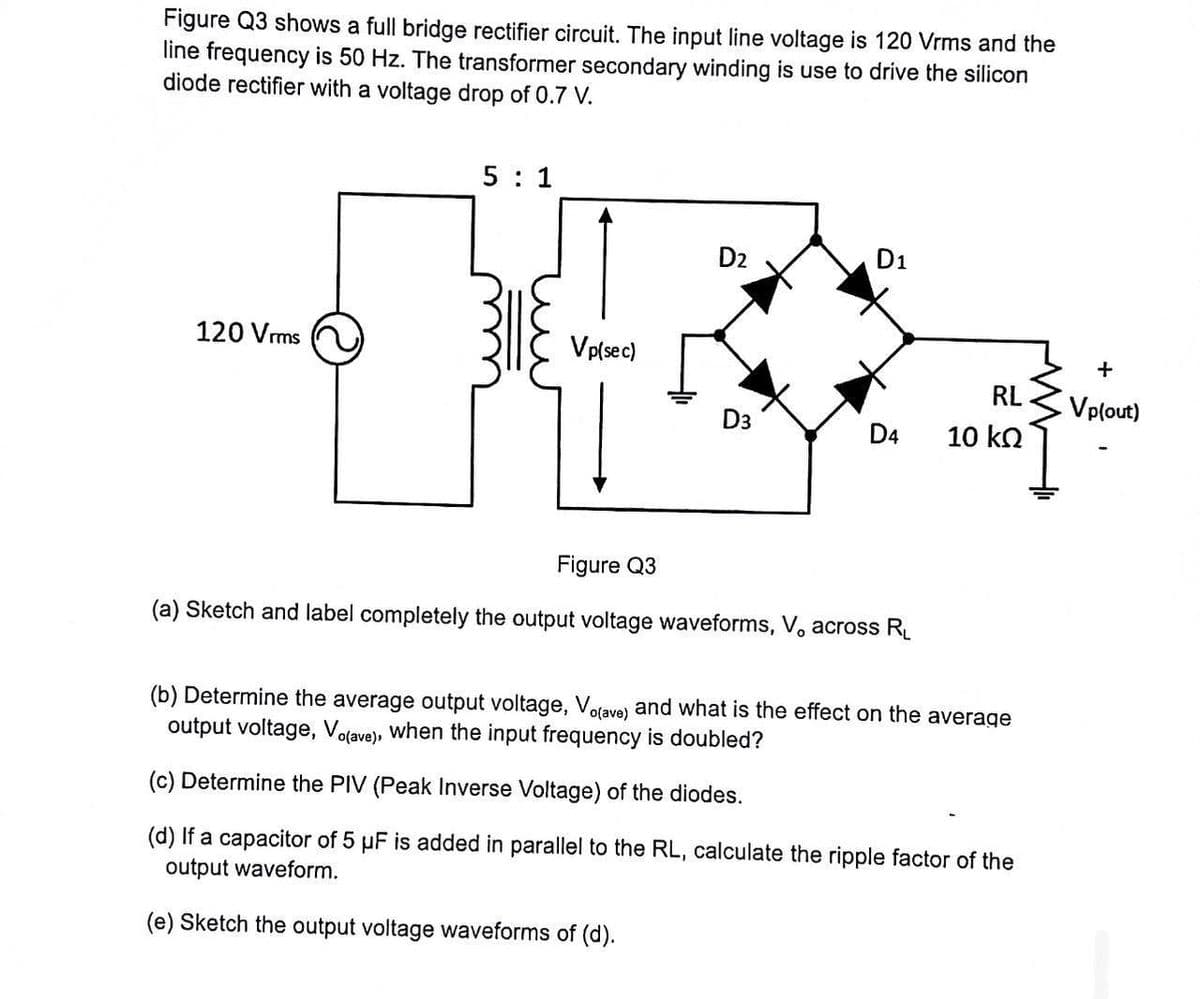Figure Q3 shows a full bridge rectifier circuit. The input line voltage is 120 Vrms and the line frequency is 50 Hz. The transformer secondary winding is use to drive the silicon diode rectifier with a voltage drop of 0.7 V. 120 Vrms 5:1 Vp(sec) D2 D3 D1 D4 Figure Q3 (a) Sketch and label completely the output voltage waveforms, V, across R₁ RL 10 ΚΩ (b) Determine the average output voltage, Vo(ave) and what is the effect on the average output voltage, Vo(ave), when the input frequency is doubled? (c) Determine the PIV (Peak Inverse Voltage) of the diodes. + Vp(out)
Figure Q3 shows a full bridge rectifier circuit. The input line voltage is 120 Vrms and the line frequency is 50 Hz. The transformer secondary winding is use to drive the silicon diode rectifier with a voltage drop of 0.7 V. 120 Vrms 5:1 Vp(sec) D2 D3 D1 D4 Figure Q3 (a) Sketch and label completely the output voltage waveforms, V, across R₁ RL 10 ΚΩ (b) Determine the average output voltage, Vo(ave) and what is the effect on the average output voltage, Vo(ave), when the input frequency is doubled? (c) Determine the PIV (Peak Inverse Voltage) of the diodes. + Vp(out)
Introductory Circuit Analysis (13th Edition)
13th Edition
ISBN:9780133923605
Author:Robert L. Boylestad
Publisher:Robert L. Boylestad
Chapter1: Introduction
Section: Chapter Questions
Problem 1P: Visit your local library (at school or home) and describe the extent to which it provides literature...
Related questions
Question

Transcribed Image Text:Figure Q3 shows a full bridge rectifier circuit. The input line voltage is 120 Vrms and the
line frequency is 50 Hz. The transformer secondary winding is use to drive the silicon
diode rectifier with a voltage drop of 0.7 V.
5:1
14
Vp(sec)
120 Vrms
D₂
D1
D4
Figure Q3
(a) Sketch and label completely the output voltage waveforms, V, across R₁
RL
10 ΚΩ
(b) Determine the average output voltage, Vo(ave) and what is the effect on the average
output voltage, Vo(ave), when the input frequency is doubled?
(c) Determine the PIV (Peak Inverse Voltage) of the diodes.
(d) If a capacitor of 5 µF is added in parallel to the RL, calculate the ripple factor of the
output waveform.
(e) Sketch the output voltage waveforms of (d).
www
+
Vp(out)
Expert Solution
This question has been solved!
Explore an expertly crafted, step-by-step solution for a thorough understanding of key concepts.
Step by step
Solved in 4 steps with 6 images

Knowledge Booster
Learn more about
Need a deep-dive on the concept behind this application? Look no further. Learn more about this topic, electrical-engineering and related others by exploring similar questions and additional content below.Recommended textbooks for you

Introductory Circuit Analysis (13th Edition)
Electrical Engineering
ISBN:
9780133923605
Author:
Robert L. Boylestad
Publisher:
PEARSON

Delmar's Standard Textbook Of Electricity
Electrical Engineering
ISBN:
9781337900348
Author:
Stephen L. Herman
Publisher:
Cengage Learning

Programmable Logic Controllers
Electrical Engineering
ISBN:
9780073373843
Author:
Frank D. Petruzella
Publisher:
McGraw-Hill Education

Introductory Circuit Analysis (13th Edition)
Electrical Engineering
ISBN:
9780133923605
Author:
Robert L. Boylestad
Publisher:
PEARSON

Delmar's Standard Textbook Of Electricity
Electrical Engineering
ISBN:
9781337900348
Author:
Stephen L. Herman
Publisher:
Cengage Learning

Programmable Logic Controllers
Electrical Engineering
ISBN:
9780073373843
Author:
Frank D. Petruzella
Publisher:
McGraw-Hill Education

Fundamentals of Electric Circuits
Electrical Engineering
ISBN:
9780078028229
Author:
Charles K Alexander, Matthew Sadiku
Publisher:
McGraw-Hill Education

Electric Circuits. (11th Edition)
Electrical Engineering
ISBN:
9780134746968
Author:
James W. Nilsson, Susan Riedel
Publisher:
PEARSON

Engineering Electromagnetics
Electrical Engineering
ISBN:
9780078028151
Author:
Hayt, William H. (william Hart), Jr, BUCK, John A.
Publisher:
Mcgraw-hill Education,